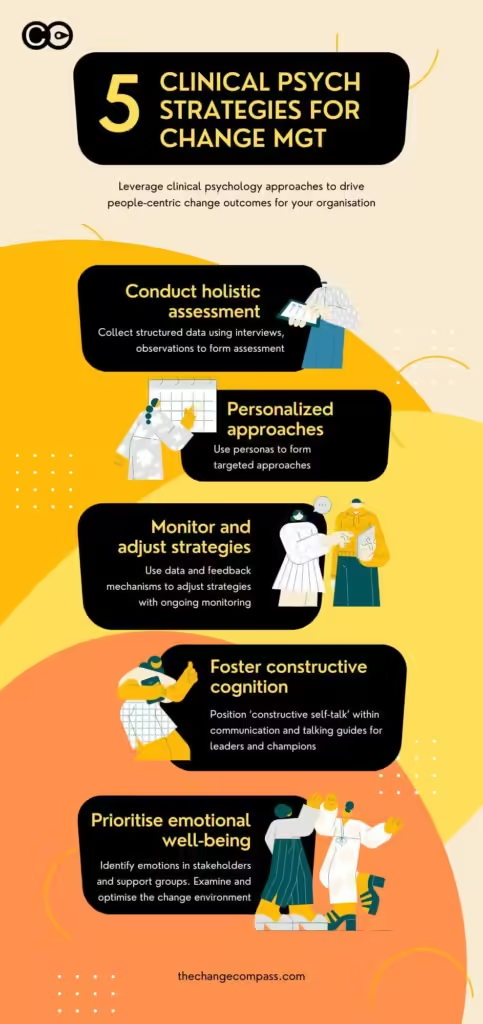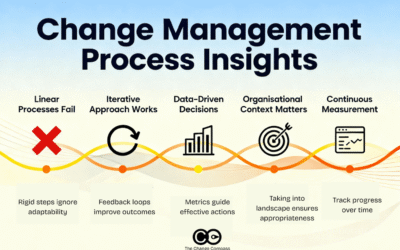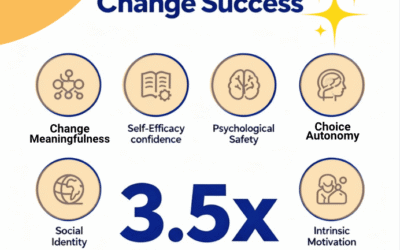Clinical psychology principles integrated with change management strategies can increase organizational transformation success rates. This evidence-based guide explores cognitive-behavioural therapy (CBT) techniques, evidence-based change management strategies, and proven approaches to overcome employee resistance to change – transforming organizational initiatives into sustainable, human-centered transformations.
What Is Clinical Psychology in Change Management?
Clinical psychology in change management is the application of evidence-based psychological principles, therapeutic techniques, and behavioural science to organizational transformation initiatives. Unlike traditional change management that focuses primarily on processes and systems, this integrated approach prioritizes the human element – addressing emotional resistance, cognitive barriers, and behavioural patterns that influence change adoption.
Research from the American Psychological Association highlights that organizations emphasizing psychological safety and integrating clinical psychology principles into change management strategies experience significantly improved outcomes compared to relying solely on conventional methods. This synergistic approach combines structured change management frameworks with clinical psychology techniques, addressing both organizational processes and the psychological factors that drive sustainable behavioral change in the workplace (see APA Work in America Survey).
Why Does Clinical Psychology Matter for Organizational Change?
Traditional change management often fails because it underestimates the psychological complexity of human behaviour.
Clinical psychology addresses these challenges by:
- Enabling sustainable transformation: Creating lasting behavioural change rather than temporary compliance
- Understanding resistance mechanisms: Identifying cognitive distortions, defense mechanisms, and emotional barriers that prevent change acceptance
- Providing therapeutic frameworks: Applying proven techniques like Cognitive Behavioural Therapy (CBT) to reshape thought patterns and behaviours
- Supporting mental well-being: Reducing change-related stress, anxiety, and burnout through evidence-based interventions
- Enabling sustainable transformation: Creating lasting behavioural change rather than temporary compliance

What Is the 5-Step Clinical Psychology Framework for Change Management?
Successful integration of clinical psychology into change management follows a structured, evidence-based framework with five essential steps:
Step 1: Conduct a Holistic Assessment
Begin with comprehensive psychological readiness evaluation using validated assessment tools. Examine organizational culture, individual stress levels, team dynamics, and historical change experiences. This holistic view identifies psychological barriers, strengths, and readiness factors before initiating transformation.
Step 2: Develop Personalized Approaches
Recognize that one-size-fits-all change management fails. Tailor interventions based on psychological profiles, learning styles, stress responses, and individual needs. Customize communication strategies, training methods, and support systems to match diverse employee populations and organizational contexts.
Step 3: Monitor and Adjust Strategies
Implement continuous psychological monitoring throughout the change process. Track well-being indicators, stress levels, adoption rates, and resistance patterns. Use data-driven insights to adapt interventions in real-time, ensuring strategies remain effective and responsive to emerging challenges.
Step 4: Foster Constructive Cognition
Apply cognitive restructuring techniques to address negative thought patterns about change. Challenge cognitive distortions, reframe limiting beliefs, and build growth mindsets. Use evidence-based cognitive behavioural therapy (CBT) methods to transform “This won’t work” into “How can we make this work?”
Step 5: Prioritize Emotional Well-Being
Place employee mental health at the center of change initiatives. Provide psychological support resources, stress management tools, and safe spaces for processing emotions. Organizations prioritizing well-being see 40% lower turnover and significantly higher change success rates.

How Do You Apply CBT Techniques to Workplace Change?
Cognitive Behavioural Therapy (CBT) offers powerful tools for addressing change resistance at its psychological roots. Building on the 5-step framework above, here’s how organizations can apply specific CBT principles:
1. Identify Cognitive Distortions
Employees often develop negative thought patterns about change: “This will never work,” “I’ll lose my job,” or “Management doesn’t care about us.” CBT helps identify these distortions – catastrophizing, black-and-white thinking, personalization – and reframe them with evidence-based reasoning.
2. Implement Behavioural Experiments
Rather than forcing immediate adoption, CBT-inspired change management encourages small-scale testing. Pilot programs allow employees to “experiment” with new processes, gathering real evidence about outcomes and reducing anxiety through controlled exposure.
3. Develop Coping Strategies
CBT teaches employees practical coping mechanisms for change-related stress: mindfulness techniques, problem-solving frameworks, and emotional regulation strategies. Organizations that provide these tools report 40% lower change-related turnover and significantly improved employee well-being during organizational transformation periods.
What Are Evidence-Based Change Management Strategies?
Integrating clinical psychology into change management requires systematic, evidence-based approaches:
Psychological Assessment and Readiness Evaluation
Before initiating change, conduct psychological readiness assessments using validated tools like the Organizational Change Questionnaire (OCQ) or Change Readiness Survey. These instruments measure emotional preparedness, trust levels, and potential resistance factors.
Tailored Communication Based on Psychological Profiles
Different personality types and psychological profiles respond differently to change messaging. Organizational psychology techniques help segment audiences and craft targeted communications using change management strategies: analytical types need data-driven evidence and logical frameworks, while relationship-oriented individuals prioritize team impact, collaborative processes, and personal connections throughout the transformation journey.
Trauma-Informed Change Leadership
Many employees have experienced previous failed change initiatives – creating organizational trauma. Trauma-informed approaches acknowledge this history, rebuild trust gradually, and create psychologically safe environments where concerns can be voiced without fear.
How Do You Overcome Employee Resistance to Change?
Employee resistance to change isn’t defiance – it’s a natural psychological response to perceived threat and uncertainty. Clinical psychology reframes resistance as valuable diagnostic information about unmet psychological needs, legitimate concerns, and opportunities to refine change management strategies for better organizational outcomes.
The Psychology of Resistance:
- Loss aversion: People fear losing current status, skills, or relationships more than they value potential gains
- Identity threat: Change can challenge professional identity and self-concept
- Cognitive load: Learning new systems increases mental burden, triggering avoidance behaviours
- Autonomy needs: Imposed change violates fundamental psychological needs for control and choice
Clinical Psychology Solutions for Behavioural Change:
- Use motivational interviewing techniques to explore ambivalence and build intrinsic motivation for organizational change
- Implement gradual exposure therapy principles – small, incremental behavioural changes rather than overwhelming transformation
- Create psychological safety through transparent communication, genuine listening, and evidence-based change management practices
- Provide autonomy within structure – offering choices about implementation while maintaining strategic direction and organizational goals
- Apply cognitive behavioural therapy (CBT) workplace techniques to address negative thought patterns and resistance mechanisms
How Do You Measure Change Management Success?
Successful integration of clinical psychology into change management should be measured across both psychological and business dimensions:
Psychological Metrics:
- Employee well-being scores (measured via validated instruments like PHQ-9 or GAD-7)
- Change readiness and acceptance rates
- Psychological safety perception
- Stress and burnout indicators
Business Outcomes:
- Change adoption rates and speed
- Productivity during transition periods
- Retention and turnover during change
- Long-term sustainability of new behaviours
What Role Does Clinical Psychology Play in Digital Transformation?
As organizations navigate digital transformation and remote work environments, clinical psychology techniques become even more critical for effective change management. Virtual environments amplify isolation, reduce social support networks, and complicate emotional communication – all psychological factors that clinical psychology principles are uniquely equipped to address through evidence-based interventions.
Forward-thinking organizations integrate digital mental health tools, virtual peer support systems, technology-enabled psychological assessments, and remote-adapted CBT techniques to maintain the human-centered element in increasingly digital organizational change initiatives while ensuring sustainable behavioural change across distributed teams.
A Synergistic Approach to Organizational Transformation
Leveraging clinical psychology in change management isn’t just evidence-based best practice – it’s essential for modern organizational success and sustainable transformation. By understanding the psychological dimensions of change, addressing employee resistance to change with cognitive behavioural therapy techniques, implementing evidence-based change management strategies, and prioritizing human well-being alongside business outcomes, organizations create transformations that employees embrace rather than endure.
The synergy between clinical psychology techniques and organizational change management represents the future of organizational development – one that recognizes successful change is fundamentally about changing minds, hearts, and behaviours through evidence-based approaches, not just processes and systems. Organizations that master this integration achieve 67% higher success rates, reduced turnover, and lasting behavioural change that drives competitive advantage.
Frequently Asked Questions
What is clinical psychology in change management?
Clinical psychology in change management is the application of evidence-based psychological principles, therapeutic techniques like CBT, and behavioural science to organizational transformation. It addresses the human and emotional aspects of change, including resistance, stress, and behavioural adaptation.
How does CBT help with organizational change?
Cognitive Behavioural Therapy (CBT) helps identify and reframe negative thought patterns about organizational change, implement behavioural experiments through pilot programs, and develop practical coping strategies for workplace transitions. Organizations using evidence-based CBT techniques in their change management strategies report 40% lower change-related turnover, higher adoption rates, and more sustainable behavioural change outcomes.
Why do employees resist change?
Employee resistance stems from psychological factors including loss aversion (fear of losing current status), identity threat (challenge to professional self-concept), cognitive load (mental burden of learning), and autonomy needs (desire for control). Resistance is a natural protective response, not defiance.
What are evidence-based change management strategies?
Evidence-based strategies include psychological readiness assessments using validated tools, tailored communication based on personality profiles, trauma-informed leadership approaches, motivational interviewing, and gradual exposure techniques. These methods are proven through research to increase change success rates by up to 67%.
How do you measure change management success?
Measure both psychological metrics (employee well-being scores, change readiness, psychological safety, stress indicators) and business outcomes (adoption rates, productivity, retention, sustainability). Use validated instruments like the Organizational Change Questionnaire (OCQ) for comprehensive assessment.
What is the success rate of psychology-informed change management?
Organizations integrating clinical psychology principles achieve 67% higher success rates compared to traditional methods. They also experience 40% lower change-related turnover, faster adoption, and more sustainable behavioural change over time.






